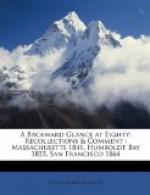We disembarked from the ancient craft and were soon leisurely pursuing our way toward the enterprising town at the other end of the track. It seemed that we were met by the entire population; for the arrival of the steamer with mail and passengers was the exciting event of the month. The station was near the southwest corner of the plaza, which we crossed diagonally to the post-office, housed in the building that had been my father’s store until he sold out the year before, when he was elected to the Assembly. Murdock’s Hall was in the second story, and a little way north stood a zinc house that was to be our home. It had been shipped first to San Francisco and then to Humboldt. Its plan and architecture were the acme of simplicity. There were three rooms tandem, each with a door in the exact middle, so that if all the doors were open a bullet would be unimpeded in passing through. To add to the social atmosphere, a front porch, open at both ends, extended across the whole front. A horseman could, and in fact often did, ride across it. My brother and I occupied a chamber over the post-office, and he became adept in going to sleep on the parlor sofa every night and later going to bed in the store without waking, dodging all obstructing objects and undressing while sound asleep.
We were quite comfortable in this joke of a house. But we had no pump; all the water we used I brought from a spring in the edge of the woods, the one found by the Gregg party on the night of Christmas, 1849. The first time I visited it and dipped my bucket in the sunken barrel that protected it I had a shock. Before leaving San Francisco, being a sentimental youth and knowing little of what Humboldt offered, I bought two pots of fragrant flowers—heliotrope and a musk-plant—bringing them on the steamer with no little difficulty. As I dipped into the barrel I noticed that it was surrounded by a solid mass of musk-plants growing wild. The misapprehension was at least no greater than that which prompted some full-grown man to ship a zinc house to the one spot in the world where the most readily splitting lumber was plentiful.
One of the sights shown to the newcomer was a two-story house built before the era of the sawmill. It was built of split lumber from a single redwood tree—and enough remained to fence the lot! Within a stone’s throw from the musk-plant spring was a standing redwood, with its heart burned out, in which thirteen men had slept one night, just to boast of it. Later, in my time, a shingle-maker had occupied the tree all one winter, both as a residence and as a shop where he made shingles for the trade.




